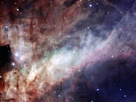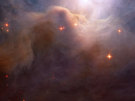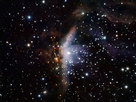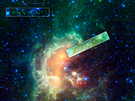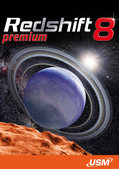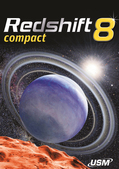Wolf–Rayet stars
Brilliant Star in a Colourful Neighbourhood
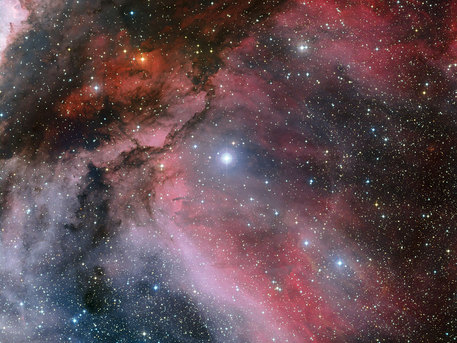 © ESO |
This image of part of the Carina Nebula was created from images taken through red, green and blue filters with the Wide Field Imager on the MPG/ESO 2.2-metre telescope at ESO’s La Silla Observatory in Chile. It is centred on the unusual hot massive young star WR 22, a member of the rare class of Wolf–Rayet stars. The field of view is 0.55 x 0.55 degrees, covering a 72 x 72 light-year region at the distance of the nebula.
WR 22 lies in the southern constellation of Carina, the keel of Jason’s ship Argo in Greek mythology. Although the star lies over 5000 light-years from the Earth it is so bright that it can just be faintly seen with the unaided eye under good conditions. WR 22 is one of many exceptionally brilliant stars associated with the beautiful Carina Nebula (also known as NGC 3372) and the outer part of this huge region of star formation in the southern Milky Way forms the colourful backdrop to this image.
The subtle colours of the rich background tapestry are a result of the interactions between the intense ultraviolet radiation coming from hot massive stars, including WR 22, and the vast gas clouds, mostly hydrogen, from which they formed. The central part of this enormous complex of gas and dust lies off the left side of this picture as can be seen in image eso1031b. This area includes the remarkable star Eta Carinae.
Source: ESO
Wolf–Rayet stars
Brilliant Star in a Colourful Neighbourhood
 © ESO |
This image of part of the Carina Nebula was created from images taken through red, green and blue filters with the Wide Field Imager on the MPG/ESO 2.2-metre telescope at ESO’s La Silla Observatory in Chile. It is centred on the unusual hot massive young star WR 22, a member of the rare class of Wolf–Rayet stars. The field of view is 0.55 x 0.55 degrees, covering a 72 x 72 light-year region at the distance of the nebula.
WR 22 lies in the southern constellation of Carina, the keel of Jason’s ship Argo in Greek mythology. Although the star lies over 5000 light-years from the Earth it is so bright that it can just be faintly seen with the unaided eye under good conditions. WR 22 is one of many exceptionally brilliant stars associated with the beautiful Carina Nebula (also known as NGC 3372) and the outer part of this huge region of star formation in the southern Milky Way forms the colourful backdrop to this image.
The subtle colours of the rich background tapestry are a result of the interactions between the intense ultraviolet radiation coming from hot massive stars, including WR 22, and the vast gas clouds, mostly hydrogen, from which they formed. The central part of this enormous complex of gas and dust lies off the left side of this picture as can be seen in image eso1031b. This area includes the remarkable star Eta Carinae.
Source: ESO





